|
JESUIT
INSTITUTIONS
IN
AUSTRIA
|
|
Karl Franzens University, Graz
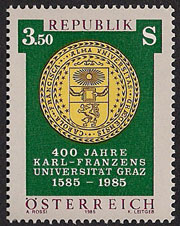
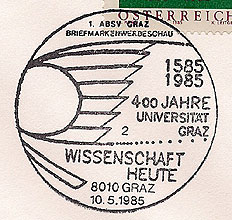
AUSTRIA, 1985, 4th centenary of the University and its special
cancel, Scott 1299
The Jesuit college of Graz, located in the capital of the Province of
Steiermark (Styria), had been founded in 1578 and was already possessed
of a theological and philosophical school. On 1 January 1585 by joint
efforts of the Pope, emperor, and Archduke Karl II of Inner Austria it
was raised to the status of a University. The first scholastic year began
in 1586. This institution of Graz was the Jesuits' center of activity
in their labors for the reclaiming of Steiermark to Catholicity. The Jesuits
ran the University until the Society was suppressed in 1773, when the
state assumed its management, though most of the imperial officials who
administrated the university and its library were former Jesuits. The
Jesuit library was combined with those of other colleges, but about 2,500
books contained in the University Library of Graz still bear the characteristic
shelf marks of the Jesuits. In 1782, it was reduced to an academy or lyceum,
but in 1827, it was again elevated to the status of university by Emperor
Francis I and called the Karl Franzens
University of Graz after its two founders. More
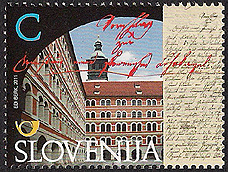
SLOVENIA, 2011, marking the bicentennial of the first chair of the Slovene
language in 1811, when the Society of Jesus was still suppressed, this stamp pictures the inner courtyard of the old Jesuit University of Graz;
the 2014 stamp in the next section gives an even wider view of the university
buildings, Scott 893
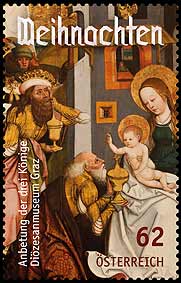
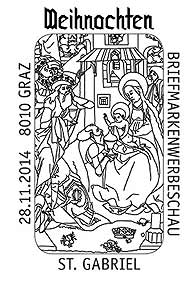
AUSTRIA, 2014, an Austrian Christmas stamp pictures a Gothic Adoration of the Magi which,
as the inscription on the stamp notes, is from the Graz Diocesan Museum,
housed in the former Jesuit University building. A FDI cancel for this stamp, designed by the St. Gabriel stamp association,
reproduces the image,. Scott 2528
The
Cathedral Church, Graz
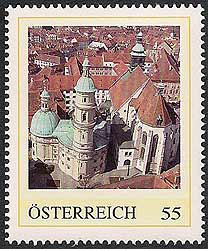
AUSTRIA, 2014, two stamps from a booklet of eight entitled "Cathedrals
of Austria" show stamps with Jesuit connections.
Above is the cathedral church at Graz, with the domed Mausoleum of Emperor
Ferdinand II to the left and the buildings of the Jesuit University in the background
The Cathedral Church began its turbulent history as a Romanesque parish
church dedicated to St. Ägydius or Giles, first mentioned in 1174.
From 1438 onwards the Duke of Austria Frederick (later to be Emperor Frederick
III) had a late Gothic courtyard and a parish church built here, which
was connected to his new residence castle until the middle of the 19th
century. In the course of history, the church saw many changes. It was
presented to the Jesuit Order in 1577 by Charles II, the Archduke of Austria.
The Jesuits, who owned the church for nearly 200 years, had it refurbished
in Baroque style in the late 17th and early 18th centuries by the best
local and foreign artists, and while the church belonged to them it was
a center of the Counter-Reformation. A gable statue of the church, St.
Catherine of Alexandria, patron saint of universities, looks to the former
Jesuit college opposite, where in 1585 Graz University was founded. After
the dissolution of the Jesuit Order and the bishop's seat in Seckau in upper
Styria it became a bishop's church of Styria in 1786
The
Calvary Hill and Church, Graz
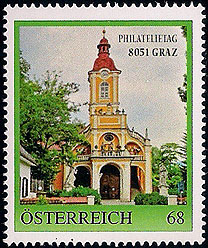
AUSTRIA, 2016 a personalized stamp for a Stamp Day showing the Calvary Hill Church built in 1668 at Graz
A Calvary Hill sometimes called a Sacred Mountain, was set of religious edifices imitating the Way of the Cross in Jerusalem, a greatly expanded versions of the Stations of the Cross that are usual in Catholic churches. Each chapel contains a large image of the scene from the Passion it commemorated, sometimes with life-sized sculpture. This was especially popular in the Baroque period when Turks ruled the Holy Land and pilgrimages there were difficult. The Grazer Calvary was the first such shrine and popular pilgrim site within the Hapsburg hereditary lands. Bernhard Walter von Waltersweil, the equerry and chamberlain of Archduke Maximilian Ernst, erected the first three crosses in 1606. On August 31, 1619 his widow handed over the site to the Jesuits, under whose care the site developed, and it was under their care until the Suppression.
The Jesuit Church in Hall in Tirol
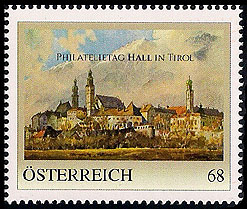
AUSTRIA, 2016, personalized stamp for a Stamp Day showing at the right the tower of the Jesuit church in Hall in Tirol.
In 1569 at the initiative of the Archduke Ferdinand of Tyrol and his sisters Magdalena and Helena Jesuits began work in Hall in Tirol. Three of the five daughters of the Emperor Ferdinand I, had moved in 1567 from Innsbruck to Hall to found a convent of which Jesuits were to be the confessors.
In 1571 Archduchess Magdalena established a Jesuit college there to minister to the needs of the convent; a grammar school was added two years later. The financial situation was such that for a while moving the school back to Innsbruck was considered, but eventually the finances improved, although the college at the best of times numbered no more than 300. The building was destroyed by an earthquake in 1670 and a new one built in 1718.
The church was remodeled in the Baroque style in the second half of the 17th century. This is one of the two churches on the Stiftsplatz that are the only sacred buildings dating back to the late-Renaissance era in the Tyrol. The Jesuit residence was completely renovated between 1671 and 1684, and dissolved in 1773 with the Suppression of the Society. Following its most recent restoration, the former Jesuit residence has one of the most beautiful Baroque courtyards in Tyrol, its grey-white facade very much in keeping with its original color.
The
University of Innsbruck, &
The Canisianum, Innsbruck
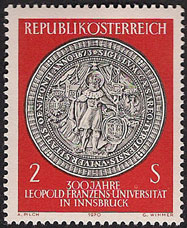
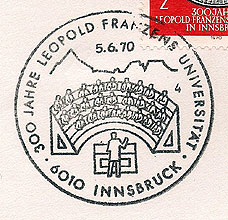
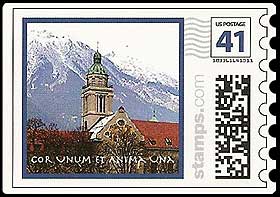
AUSTRIA, 1970, The 300th anniversary of the University of Innsbruck and
its FDI cancel, Scott 863
THE UNITED STATES, 2006, a personalized stamp featuring the signature tower of the Canisianum
and the mountains north of Innsbruck, the Nordkette.
The history of the University of Innsbruck starts about 100 years before
its official foundation in 1669, when in 1562 a Jesuit school
was established in Innsbruck, today the "Akademisches Gymnasium Innsbruck." Emperor Leopold I used this Jesuit school as a foundation to establish
a university on 15 October 1669. Eight years later in 1677, the founding
certificate was issued, which mentioned four faculties. In 1782 this was
reduced to a mere lyceum (as were other Universities in the Austrian Empire),
but by this time the Jesuits had been suppressed and any relation to the
school severed. The school was reestablished as the University of Innsbruck
in 1826 by Emperor Franz I. The university is therefore named after both
of its founding fathers with the official title of: "Leopold-Franzens-Universität
Innsbruck" (Universitas Leopoldino-Franciscea).
In 2006 Richard Wall commissioned a personalized stamp on behalf of the
American alumni of the Jesuit school in Innsbruck, the Canisianum, a seminary
named in honor of St. Peter Canisius. The National Socialists forced the
school to close in 1938 and it did not reopen until 1945. Its roots go
back to 1569 when the Nikolaihaus, founded by Fr. Nikolaus de Lanoy, SJ,
served as a residence for poor students at the Jesuit College. When Kaiser
Leopold I founded the University of Innsbruck in 1669, the Nikolaihaus
became a residence for theology students at the University. Even after
the Suppression the house continued under the leadership of a former Jesuit.
In 1857 the restored Catholic Theological Faculty was entrusted to the
Jesuits and the Nikolaihaus once more became a residence for theological
students. In 1910-1911 it achieved independence and moved to new quarters.
Since 2006 the Collegium Canisianum has received a new mission as an International
Theological College for postgraduate, specialist and continuing education
purposes. Also featured on the stamp is the motto of the school: Cor Unum
et Anima Una (One Heart and One Soul).
The
Cathedral Church, Klagenfurt
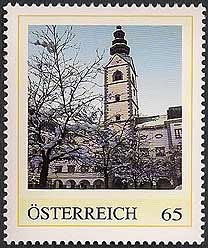
AUSTRIA, 2014, two stamps from a booklet of eight entitled "Cathedrals
of Austria" show stamps with Jesuit connections.
Above is the cathedral church at Klagenfurt.
The cathedral and parish church of Saints Peter and
Paul, also known as Klagenfurt Cathedral, is the cathedral of the
Roman Catholic Diocese of Gurk-Klagenfurt and the main parish church
of Klagenfurt. It was built by Protestants and dedicated to the Holy
Trinity in 1581, and was the largest Protestant church in Austria
at that time. It was commissioned by Christoph Windisch, Klagenfurt'
s first mayor. In 1604, during the Counter-Reformation, Ferdinand
of Styria, later Emperor Ferdinand II, confiscated the church and
transferred it to the Jesuits, and it was rededicated to the Apostles
Peter and Paul. The church was razed to the ground by a fire and had
to be rebuilt in 1724. After the Suppression in 1773 and a new division
of the dioceses in Austria, it became the cathedral of the Diocese
of Gurk-Klagenfurt in 1787.
The
Jesuit Churches & Retreat House, St. Andrä im Lavanttal
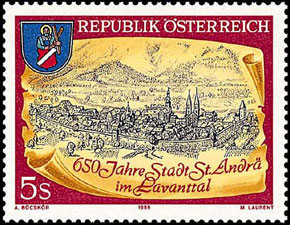
AUSTRIA, 1989, this 17th-century map shows the twin towers of the parish
church, Scott 1462
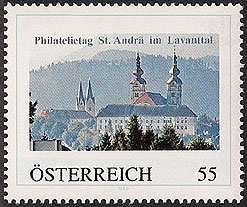
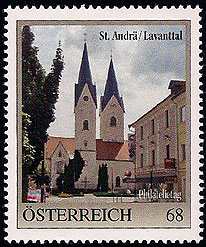
AUSTRIA, 2010, personalized stamp for Stamp Day of St. Andrä im
Lavanttal showing both the parish church and that of Maria-Loreto.
AUSTRIA, 2016, personalized stamp for Stamp Day
showing St. Andrä im
Lavanttal.
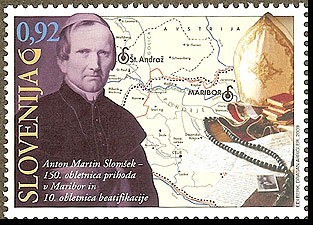
SLOVENIA, 2009, the anniversary of the transfer of the seat of the Diocese
of Levant from St. Andrä to Maribor, Scott 806
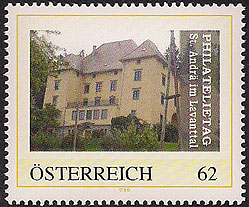
AUSTRIA, November 2011, personalized stamp featuring the former Jesuit
Retreat House, Schloss Kolleg
St. Andrä im Lavanttal had been the seat of the Prince-Bishops of Lavant from 1225 to 1859,
when the see was transferred to Marburg, now Maribor in Slovenia, by
the Bishop of Levant, Blessed
Anton Martin Slomšek (seen above). In connection with the transfer,
he also reorganized the diocese of Lavant. This was both an historical,
pastoral and national accomplishment. By these moves Slomšek managed
to include in his diocese about 200,000 Slovenes who before belonged
to the diocese of Graz and who would have been lost to German influence.
He left St. Andrä in August and later that year the Jesuits moved
into the former bishop's residence there and opened a novitiate and
later a tertianship. This was where Fr. Karl Rahner, SJ, famous Jesuit
theologian, made his tertianship. The Jesuits also took over the twin-towered
Baroque church of Maria-Loreto dating from 1697 and the parish church,
which goes back to the ninth century. Only in 1969 did the novitiate
move to Germany, and the Jesuits moved out of the former bishop's residence
to open a retreat house (Schloss
Kolleg) outside of town. The building serves today as a residence
for the elderly under the name Elizabeth
House. The parish church of St. Andrä was under the caare of the Jesuits from 1945 to 2007.
The
Aloisianum, Linz
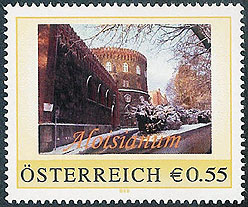
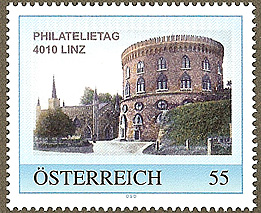
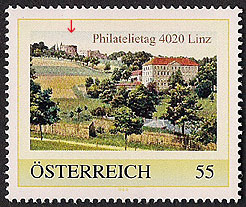
AUSTRIA, personalized stamp, Scott 1943
AUSTRIA, 2009, personalized stamp on Stamp Day
AUSTRIA, 2010, personalized stamp on Stamp Day
each stamp shows Maximilian's Church and the Freinberg tower of St. Aloysius
Jesuit College
In Austria as elsewhere one can order stamps, valid for regular postal
service, with personally chosen images and text. The personalized stamps
above show St. Aloysius Jesuit College (Jesuitenkollegium Aloisianum)
on the Freinberg near Linz, Austria. You can see Maximilian's Church (Maximilianskirchlein)
and the Freinberg tower which houses part of the school. Archduke Maximilian
of the House of Habsburg-Este, Grand Master of the Teutonic Order, donated
the church and the tower to the Jesuits of the Austrian province in 1837.
It was the first residence of Austrian Jesuits after their readmission
into Austria and was used as a philosophate for Jesuit scholastics until
the Revolution of 1848.
Beginning in 1851 the Jesuits ran a minor seminary here to encourage
clerical and missionary vocations. The school outgrew the tower and the
same Archduke Maximilian soon had a large boarding school built, which
can be seen to the right of the tower. The school closed in 1897
with the founding of the Petrinum, a diocesan seminary. It reopened in
1912 as the Collegium Aloysianum, but was adversely affected by the World
War, the use of the building as a military hospital, and the economic
and social problems following the war. In spite of that, it was in some
ways the Golden Age of the school. In the 1920s and 1930s large numbers
graduated and chose the clerical life or joined religious communities.
About 50 joined the Jesuits, and many of these went to the Jesuits missions
in China and Brazil. The school was closed by the National Socialists
in 1938, but was returned to the Jesuits in 1946 and in 1950 opened as
a high school for the third time. Today, after many changes in structure,
it is a private Catholic school dedicated to Christian education, but
without Jesuit teachers.

1976, meter stamp from the Aloysianum
St.
Ignatius Church, Linz
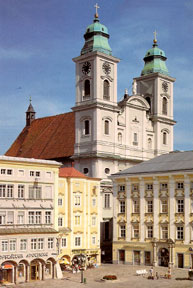

Exterior and Interior of St. Ignatius church
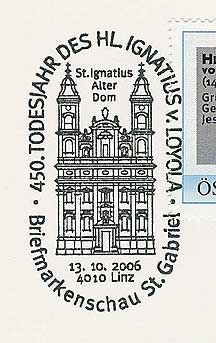

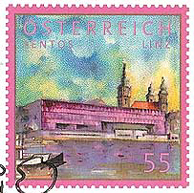
AUSTRIA, 2006, a special show cancel, featuring the Old
Cathedral or St. Ignatius Church, one time a Jesuit Church
AUSTRIA, 2007, on a postal card honoring the Lentos Art Museum both stamp
and cancel show the twin towers of St. Ignatius Church
The Old Cathedral in the Town Hall District of Linz, the capital of Upper
Austria, was originally a Jesuit church. It was called St.
Ignatius Church until 1909 when the new Cathedral of the Immaculate
Conception was finished; since then it has been known as the Old Cathedral.
The church was built between 1669 and 1678 according to drawings by the
Italian architect Pietro Francesco Carlone. From the Suppression of the
Jesuits in 1773 until 1785 when the Diocese of Linz was established the
church remained empty. Ernest Johann Nepomuk Graf von Herberstein, the
first bishop of the new diocese of Linz, chose the Church of St. Ignatius
as his cathedral, instead of the town parish church,
which had been earmarked for this purpose. It served as the cathedral
of Linz from 1785 to 1909, when it was return to the Jesuit Order. It
is still the largest Baroque church in the city. It features the "Bruckner
Organ" adapted especially according to the wishes of Anton Bruckner,
who was cathedral organist here from 1855 to 1868.
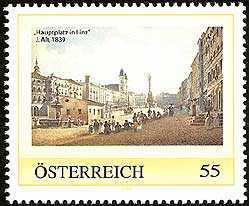
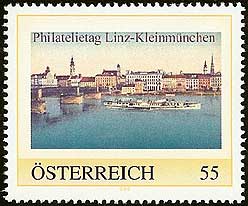
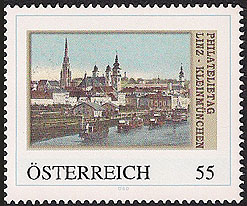
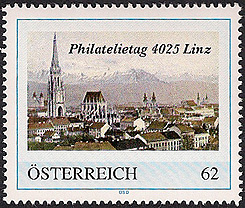
AUSTRIA, 2008, a personalized stamp features Jakob Alt's painting of
the main square of Linz (1839)
with the twin towers of St. Ignatius Church in the distant center
AUSTRIA, 2008, a personalized stamp for Stamp Day 14 May 2008, showing
the same towers in the distance.
AUSTRIA, March 2011, personalized stamp featuring the Old Cathedral
AUSTRIA, 2012, personalized stamp for Stamp Day; the twin towers of the
old cathedral are to the far left; the large tower is the new cathedral
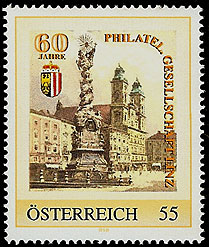

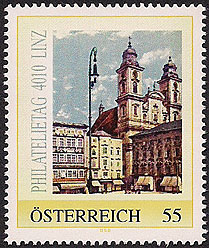
AUSTRIA, 2009, to the left a personalized stamp featuring St. Ignatius
Church and the Trinity Column in Linz's Main Square and
in commemoration of the 60th anniversary of the Linz Philatelic Association
AUSTRIA, 2009, personalized stamp marking 100 years since Jesuits have
returned to the Old Cathedral
AUSTRIA, 2010, personalized stamp for stamp day
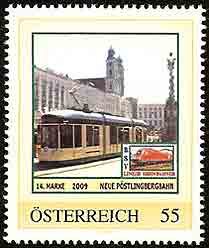
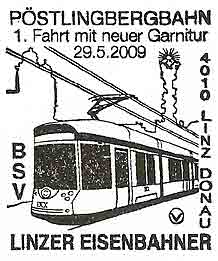
AUSTRIA, 2009, personalized stamp marking the new equipment for the
Pöstlingberg railway up the landmark mountain of Linz and special cancel
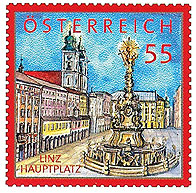
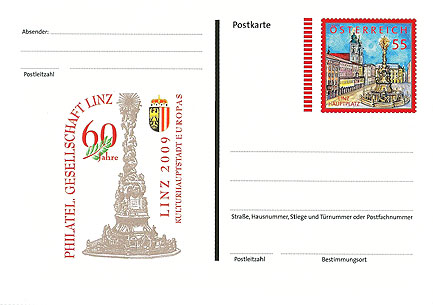

AUSTRIA, 2009, a postal card showing the twin towers of St. Ignatius
more clearly and the Trinity Column.
The imprint on the card and the special cancel to the right commemorate both
the Philatelic Association anniversary
and the naming of Linz by the European Union as a European Capital of Culture
for the year 2009.
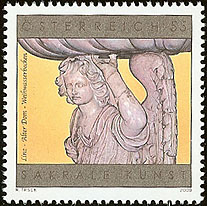

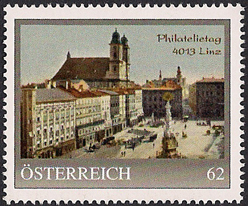
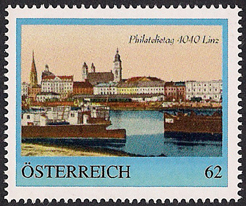
AUSTRIA, 2009, Religious art in Austria showing the Baroque baptismal
font in the Old Cathedral, Linz and its FDI cancel
AUSTRIA, 2014, two personalized stamps for Stamp Day
The
Parish Church, Linz
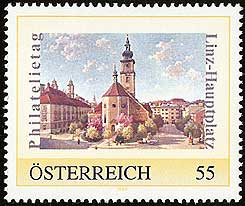
AUSTRIA, a personalized stamp in honor of stamp day 4 August 2008
featuring the Parish church of Linz, and in the background the towers
of St. Ignatius Church
The Stadtpfarrkirche "Maria Himmelfahrt" (Parish Church of
Our Lady's Assumption), one of the oldest churches in Linz, has Romanesque
and Gothic origins, still evident, for example, in the structure of the
tower. The 13th-century basilica was rebuilt in the Baroque style in the
17th-century and was inaugurated in 1656. The heart and entrails of Emperor
Friedrich III are interred in an urn in the choir. This personalized stamp
shows the church, just a block away from the Church of St. Ignatius (the
Old Cathedral). When the first two Jesuits, one of them Fr. Georg Scherer,
SJ, arrived in Linz in the year 1600, they settled in a former Franciscan
friary and ran their ministry from this church. Until the Church of St.
Ignatius was finished in 1679 there was a connecting passageway between
the Jesuit college and the parish church. But even after St. Ignatius
Church was completed the Jesuits continued to work in the parish church
for more than a century until the Suppression in 1773.
Jesuit
Missionshaus, Maria Sorg, Salzburg
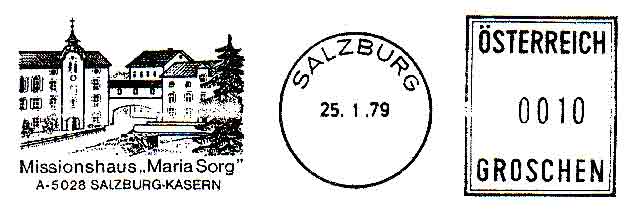
1979, Meter stamp for the Jesuit "Missionshaus" at Maria Sorg, Salzburg
Marienkirche,
Steyr
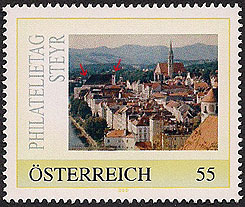
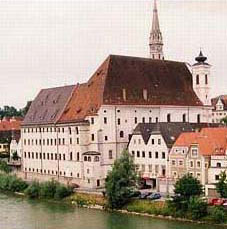
AUSTRIA, 2010, a personalized stamp for stamp day
added red arrows indicate the location of the Marienkirche, the present residence
of Jesuits in Steyr
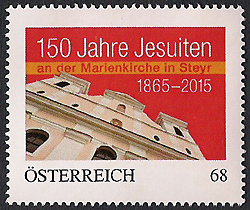
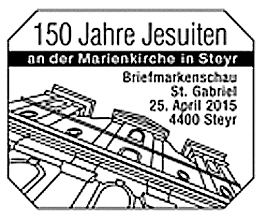
AUSTRIA, 2015 special show stamp and cancel marking 150 years of the Jesuits in Steyr
In 1472 Dominicans from Krems founded a church and monastery
in Steyr, both of which were destroyed in the city fire of 1522. In 1559
the people of the town asked the Emperor Ferdinand I to permit the reconstruction
of the church and monastery for use as a Protestant school. Permission
was granted but the rights of the Dominicans to the place were reserved.
As part of the Counter-reformation the church was returned to the Dominicans
on 10 November 1624 , and monastery on 12 February 1625. The church was
redone in Baroque style between 1642 and 1647. In 1785 in the course of
the reforms of Emperor Joseph II the monastery was close. During the Napoleonic
Wars (1800-1809), the church was used as a barn. On 26 April 1865 the
Bishop of Linz, Franz Josef Rudigier handed it over to the Society of
Jesus for the pastoral work they had begun in Steyr. No rooms were available
in the monastery, and so the first Jesuits had to live in the former choir
room behind the main altar. But they moved to the monastery in 1911 and
have been there ever since. The latest restoration of the church (inside
and out) took place from 1975 to 1978.
St.
Michael Church, Steyr
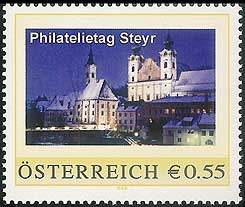
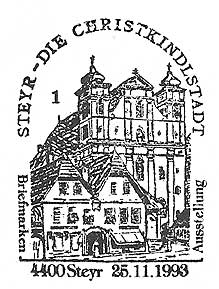

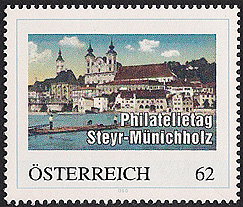
AUSTRIA, 2006, a personalized stamp, Scott 1943
AUSTRIA, 1993, special stamp show cancel
AUSTRIA, 2010 and 2012, personalized stamps for the Steyr-Munichholz
Stamp Day
all showing St. Michael's Church
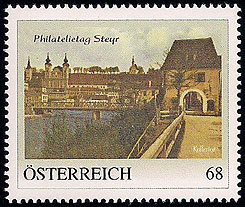
AUSTRIA, 2016, a personalized stamp for Stamp Day showing St. Michael Church at the left, Scott 1943
The Jesuits arrived in Steyr in upper Austria in 1632 when Kaiser Ferdinand
II granted them 11 houses. At first they worked in the old civil hospital
church (at the lower left of the stamp). In 1634 they opened a college
(gymnasium), and in 1635 built St. Michael Church (upper right of stamp).
A few years before the Suppression the church was redone in Baroque style
and a fresco of three archangels was painted on the front of the church
at the top. After the Suppression (1773) the church became a parish church,
and when the Jesuits returned to Steyr in 1865, they were given the former
Dominican Church, the Marienkirche, just a few minutes from St. Michael's.
Kollegium
Kalksburg, Vienna


1988-1991, meter stamps for Kollegium Kalksburg, a Jesuit secondary school in
Vienna. More
St.
Barbara Church, Vienna
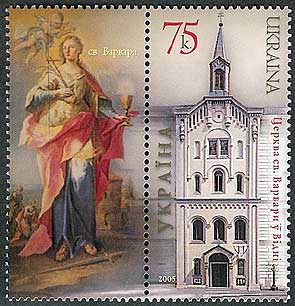
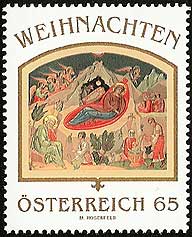
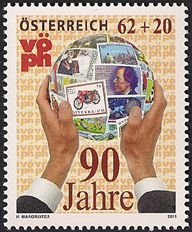
UKRAINE, 2005, Ukrainian Churches outside of Ukraine, stamp and label,
Scott 617
AUSTRIA, Christmas 2007, the icon
of the Birth of Christ is from the Church of St. Barbara, Scott 2127
AUSTRIA, 2011, the Federation of Austrian Philatelist Societies' 90th
birthday, Scott 2127, appears under the holder's right thumb
In 1773, after the Suppression of the Jesuits, the Church of St. Barbara
in Vienna, Austria was given to the Ukrainian Greek Catholic Church by
Empress Maria Theresa. Prior to that time it was run by the Jesuits along
with the adjoining St. Barbara residence for students at the Jesuit University.
The Jesuits arrived in Vienna in 1551 and in 1554 moved into the Carmel
Cloister Am Hof. Their college opened in 1560 and St.
Stanislaus Kostka, SJ attended the school four years later. St. Barbara
was patroness of the boarding students, the school Sodality, and figured
in a significant vision of St. Stanislaus. In 1654 a new boarding school
was erected adjacent to St. Barbara Church in the Inner City just a block
or so northeast of the Jesuit church and the old university. The facade
of the church shown on the stamp is how it was renewed in 1852; the label
shows the altarpiece of the church with St. Barbara and the features of
the Empress Maria Theresa.
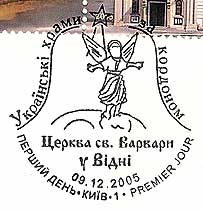
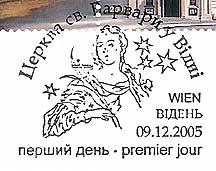
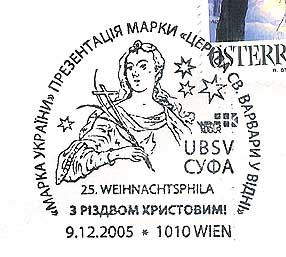
UKRAINE, FDI cancel featuring angel, issued at Kiev
UKRAINE, FDI cancel featuring altarpiece of St. Barbara Church
AUSTRIA, FDI special show cancel featuring altarpiece of St. Barbara
Church
The
Theresianum Academy, Vienna
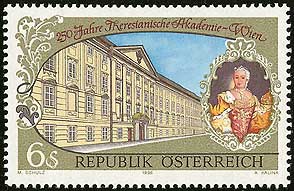
AUSTRIA, 1996, the 250th anniversary of the Theresianum, Scott
1695
On February 24, 1746 Empress Maria Theresa arranged to transfer her imperial
summer residence, the Favorita, to the Society of Jesus for the establishment
of an elite school for the education of the children of nobles —
the Theresianum. She was the school's founder and under her patronage
its economic sponsorship was secured and its curriculum was established.
The Jesuits introduced a new system including Mathematics, History, Architecture,
Geography, Political Science, Modern Languages, as well as Dancing, Horseback
Riding and Fencing. Its graduates were destined for the diplomatic corps
or other public service. Such a school was also called a knight academy
(Ritterakademie). The Jesuits ran it until the Suppression in 1773; the
faculty included Jesuit priests: Johann
Nepomuk Cosmas Michael Denis, George
Pray, and Franz Xavier Freiherr von Wulfen.
After the Suppression some former Jesuits continued to teach there. It
was dissolved by Joseph II, but reestablished in 1797 by Emperor Franz
II. As it celebrated its 250th anniversary in 1996, the school had over
600 students.
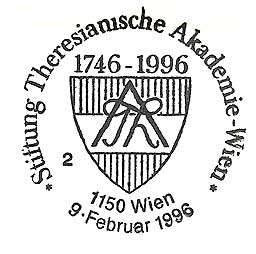
AUSTRIA, 1996, FDI cancel for the 250th anniversary of the Theresianum
The
University Church, Vienna
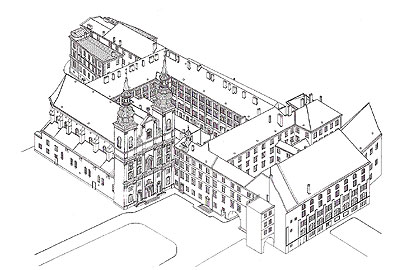
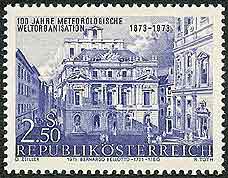
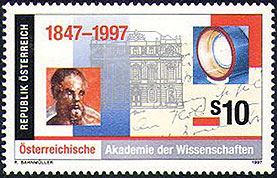
AUSTRIA, 1973, the centenary of a worldwide meteorological association
with the church facade on the right, Scott 950
AUSTRIA, 1997, another view of the academy, Scott 1716
Duke Rudolph IV founded the University of Vienna in 1365 along the lines
of the Sorbonne in Paris. In the course of the Reformation the University
of Vienna, a papal institution, suffered a great loss of prestige, and
for a variety of reasons the number of students also declined. King Ferdinand
I tried to counteract this with new reforms. He installed the Jesuits
there in 1551, and gave them two theological chairs. When tensions arose
between the Jesuit school and the university, Emperor Ferdinand II passed
the 1623 Sanctio Pragmatica, making the Jesuits the teachers at
the theological and philosophical faculties. The Jesuits integrated their college into the University of Vienna. Part of
their reconstruction of buildings at this time was to erect the University
church in place of the former chapel. The Emperor broke ground for college
and church the following year, and the church was dedicated to Saints
Ignatius Loyola and Francis Xavier who
had recently been canonized. From 1703 to 1705 it was remodeled by Br.
Andrea Pozzo, SJ who added two new towers. The student numbers rallied,
and the Jesuit Order kept its dominant position in the University for the
next 150 years.
The central feature of the above 1973 stamp, based
on a painting by Bernardo Bellotto, called Canaletto (1720-90), is the
facade of the old university at Dr. Ignaz Seipel Place. It had been the
seat of the Academy of Sciences since 1857 and the main building, the Alte Aula, or Congregation Hall of the University
at the time. This building faced the Jesuit residence and school, and
between them was the facade of the Church. To its right is the Baroque
Jesuit University church dating from 1630, which the Jesuits left at the
time of the Suppression. towers and frescoes inside; the
remodeled church was then dedicated to the Assumption of Mary. The state
took it over at the time of the Suppression and has recently renovated
it.

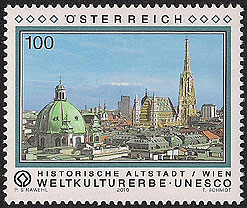

AUSTRIA, 1964, the Vienna International Philatelic Exhibition (WIPA 1965)
issue showed views of Vienna including one to the east
showing the towers of the University Church between the dome of St. Peter and
the church and spire of St. Stephen, Scott B308
AUSTRIA, 2010, a similar view, honoring the Vienna city center as a UNESCO
World Heritage site, Scott 2286
AUSTRIA, 2011, The Federation of Austrian Philatelist Societies' 90th
birthday, Scott 2286 appears under the "62"
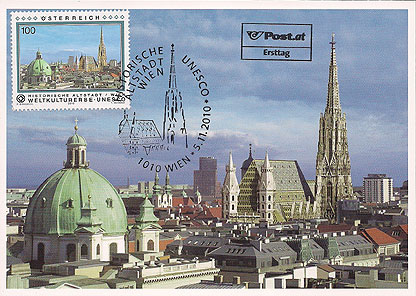
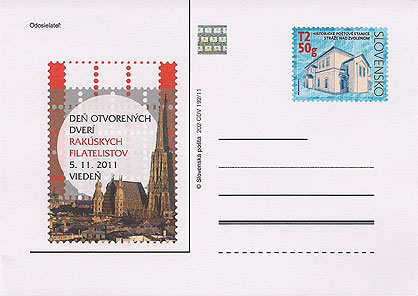
AUSTRIA, 2010, The two towers of the church are seen more clearly on
the card below immediately under the FDI cancel, Scott 2286
SLOVAKIA, 2011,Opening Day of Austrian Philatelists 2011, the twin towers
are on the horizon at the right [issue number 202 CDV 192/11]
NEXT



































































